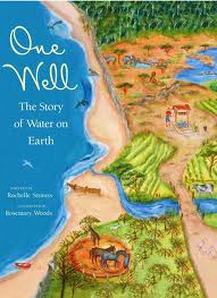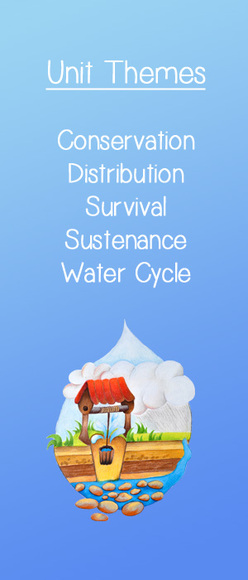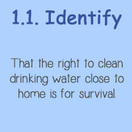Classroom Learning Activities

1. One Well: The Story of Water on Earth - Learning Resource Material:
Water has the power to change everything — a single splash can sprout a seed, quench a thirst, provide a habitat, generate energy and sustain life. How we treat the water in the well will affect every species on the planet, now and for years to come. All living things depend on Earth’s One Well. Life would be impossible without it. But the water in the Earth’s well is threatened by our growing population and increased demands. What can we do to protect it? One Well answers this important question while telling the eye-opening story of water on Earth. Includes learning about:
|
The Magic School Bus - How Water Changes
|
2. Explore the 4 Important Principles of Water
- Availability - this means that each person has the right to enough quantity of water for all uses, personal and domestic. How many litres of water does each person need each day?
- Accessibility - Adequate facilities and services must be accessible in the home or close to home and the water must be affordable for all. (Explored more in Sub-Unit 1.2)
- Quality - Water must be clean, potable and free of health risks.
- Reliability and Stability - Clean water must be available and accessible in all circumstances (drought, flood, etc)
Relevant Convention Articles
Article 6
1. States Parties recognize that every child has the inherent right to life.
2. States Parties shall ensure to the maximum extent possible the survival and development of the child.
Article 24
1. States Parties recognize the right of the child to the enjoyment of the highest attainable standard of health and to facilities for the treatment of illness and rehabilitation of health. States Parties shall strive to ensure that no child is deprived of his or her right of access to such health care services.
2. States Parties shall pursue full implementation of this right and, in particular, shall take appropriate measures:
(a) To diminish infant and child mortality;
(b) To ensure the provision of necessary medical assistance and health care to all children with emphasis on the development of primary health care;
(c) To combat disease and malnutrition, including within the framework of primary health care, through, inter alia, the application of readily available technology and through the provision of adequate nutritious foods and clean drinking-water, taking into consideration the dangers and risks of environmental pollution;
(d) To ensure appropriate pre-natal and post-natal health care for mothers;
(e) To ensure that all segments of society, in particular parents and children, are informed, have access to education and are supported in the use of basic knowledge of child health and nutrition, the advantages of breastfeeding, hygiene and environmental sanitation and the prevention of accidents;
(f) To develop preventive health care, guidance for parents and family planning education and services.
3. States Parties shall take all effective and appropriate measures with a view to abolishing traditional practices prejudicial to the health of children.
4. States Parties undertake to promote and encourage international co-operation with a view to achieving progressively the full realization of the right recognized in the present article. In this regard, particular account shall be taken of the needs of developing countries.
1. States Parties recognize that every child has the inherent right to life.
2. States Parties shall ensure to the maximum extent possible the survival and development of the child.
Article 24
1. States Parties recognize the right of the child to the enjoyment of the highest attainable standard of health and to facilities for the treatment of illness and rehabilitation of health. States Parties shall strive to ensure that no child is deprived of his or her right of access to such health care services.
2. States Parties shall pursue full implementation of this right and, in particular, shall take appropriate measures:
(a) To diminish infant and child mortality;
(b) To ensure the provision of necessary medical assistance and health care to all children with emphasis on the development of primary health care;
(c) To combat disease and malnutrition, including within the framework of primary health care, through, inter alia, the application of readily available technology and through the provision of adequate nutritious foods and clean drinking-water, taking into consideration the dangers and risks of environmental pollution;
(d) To ensure appropriate pre-natal and post-natal health care for mothers;
(e) To ensure that all segments of society, in particular parents and children, are informed, have access to education and are supported in the use of basic knowledge of child health and nutrition, the advantages of breastfeeding, hygiene and environmental sanitation and the prevention of accidents;
(f) To develop preventive health care, guidance for parents and family planning education and services.
3. States Parties shall take all effective and appropriate measures with a view to abolishing traditional practices prejudicial to the health of children.
4. States Parties undertake to promote and encourage international co-operation with a view to achieving progressively the full realization of the right recognized in the present article. In this regard, particular account shall be taken of the needs of developing countries.
Online Resources and References
Ryan's Well Foundation grew from the commitment of one boy, Ryan Hreljac, who learned of the great need for clean and safe water in developing countries in his 1st grade class. With the support of friends, family and the community, Ryan raised enough money to build a well in Africa. In 1999, at age seven, Ryan's first well was built at Angolo Primary School in northern Uganda.
Humanium - Help the Children: Right to Water
How Stuff Works - How Water Works: Human Consumption
Global Change - Human Appropriation of the World's Fresh Water Supply
The Water Information Program - Water Facts
United Nations Data Collection World-O-Meters - Water Consumption: Sources and Methods
Kids' Crossing - Cycles of the Earth: Living in the Greenhouse!
USGS - Science for a Changing World: The USGS Water Science School
Water Field Day for Elementary School Students
Humanium - Help the Children: Right to Water
How Stuff Works - How Water Works: Human Consumption
Global Change - Human Appropriation of the World's Fresh Water Supply
The Water Information Program - Water Facts
United Nations Data Collection World-O-Meters - Water Consumption: Sources and Methods
Kids' Crossing - Cycles of the Earth: Living in the Greenhouse!
USGS - Science for a Changing World: The USGS Water Science School
Water Field Day for Elementary School Students






